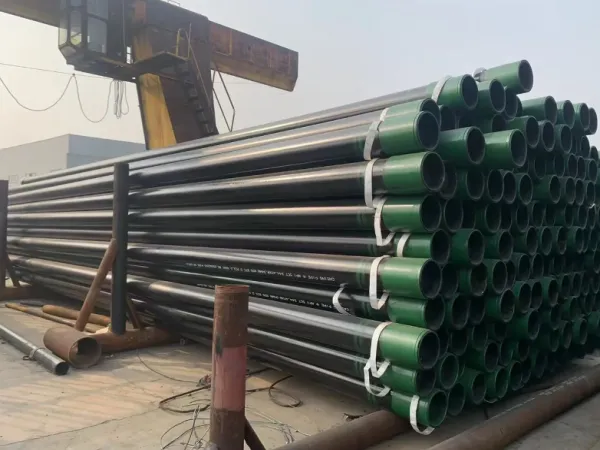What is API 5CT oil casing hydrostatic test?
API 5CT oil casing pipe hydrostatic test is to test the pipe at a specified pressure when the pipe is filled with water to see if there is leakage or rupture in the pipe. It is used to detect the anti-leakage ability of steel pipes under standard test pressure and pressure stabilization time. It is an indispensable part of the steel pipe manufacturing process. The operation includes three steps: pipe flushing, pressure testing, and water control. Today we will introduce the API 5CT oil casing hydrostatic test in detail.
The oil casing pipe hydrostatic test machine can be used for the pressure resistance test of oil
casing pipe. It adopts the pressurization form of pressurized cylinder, with fast pressurization speed, stable and reliable. Equipped with automatic control technology, it can display water pressure curves, input and output test statistics, and store test statistics.
The commonly used description method is to fill the oil casing pipe with water and pressurize it to see how long it can withstand without rupture or leakage. Its operation is divided into three steps: water control, pressure test and flushing.
API 5CT oil casing hydrostatic test:Main technical operation points of this position
1. Parameter setting: According to the specifications, steel grade and thread type of the oil casing pipe, specify the test pressure value, pressure stabilization time and other parameters;
2. Each pipe must be thoroughly hydrostatically tested, and the minimum and actual pressure stabilization time must comply with the provisions of the process card (the pressure stabilization time may be occasionally modified according to the quality of the raw materials);
3. When performing the pressure test procedure, check whether each seal is intact and there is no leakage;
4. The standard hydrostatic test pressure is the test pressure control range of the pipeline. Fill in the hydrostatic test record carefully.

Key points of later technical operation:
1. Parameter setting: set the test pressure value and pressure stabilization time according to the specifications, steel grade and thread type of the tested pipe;
2. Perform a hydrostatic test on the entire length of each pipe. The actual test pressure and minimum pressure stabilization time must comply with the provisions of the process card (sometimes the pressure stabilization time is appropriately adjusted according to the quality of the raw materials);
3. During the pressure test, check whether the seal is intact and whether there is any leakage at any time;
4. The control range of pipeline test pressure is: ≥ standard water pressure test pressure;
Precautions for subsequent operation:
1. When the actual water pressure test pressure does not reach the standard pressure due to equipment reasons, the technical department should be notified in time to make corresponding process adjustments.
2. If the pressure stabilization effect is not good during the pressure test, check whether there is leakage in each seal and pipeline, and repair it if necessary.
3. After the pressure test, pay attention to check whether there are any knock marks on the pipe body.
API 5CT standard hydrostatic pressure test related regulations:
1. The hydrostatic test pressure value of threaded pipes with couplings is the lowest of the flat head pipe hydrostatic test pressure, the coupling maximum hydrostatic test pressure, and the internal pressure anti-leakage capacity, but the standard maximum pressure is 69MPa. The calculated pressure value is generally rounded to the nearest 0.5MPa.
2. According to API requirements, the hydrostatic test pressure measuring device should be calibrated within 4 months before each use.
3. If the customer has special requirements, a higher hydrostatic test pressure can be selected.
4. Leakage found in the hydrostatic test is the basis for rejection.
5. Unless otherwise agreed by the supply and demand parties, the coupling blank, coupling material, adjacent materials or Q125 steel grade taps do not need to be hydrostatically tested.






 English
English Español
Español بالعربية
بالعربية











 Phone :
Phone :  Whatsapp :
Whatsapp :  Email :
Email : 


